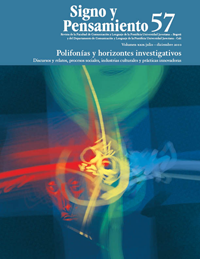Abstract
As part of the commemoration of the 100th anniversary of Marshall McLuhan (2011), the LabCom Interdisciplinary Research Group has been carrying out a selfreflective experiment in both virtual and real scenarios: Second Life, Twitter, Elluminate and Google Wave. It seeks to explore the possibilities these platforms offer as scenarios for exchanging ideas and academic “writing”, as well as for supporting and recording research processes. This process is a research performance, and seems to be a valid choice in action-research, as well as an experiment on academic writing using new formats.
Alabaladejo, T. (1998), Teoría de los mundos posibles y macroestructura narrativa, Murcia, Universidad de Alicante.
Ardèvol, E. (1998), “Por una antropología de la mirada: etnografía, representación y construcción de datos audiovisuales”, Revista de Dialectología y Tradiciones Populares, tomo liii, Cuaderno Segundo, pp. 217-240.
Barret, E. B. y Redmon, M. (1997), Medios contex- tuales en la práctica cultural. La construcción social del conocimiento, Barcelona, Paidós.
Borrás, L. (2004), Textualidades electrónicas. Nuevos escenarios para la literatura, Barcelona, uoc. Buckingham, D. (2008), Más allá de la tecnología, Buenos Aires, Manantial.
Casacuberta, D. (2003), Creación colectiva. En: Internet el creador es el público, Barcelona, Gedisa.
Contursi, M. E. y Ferro, F. (2000), La narración, usos y teorías, Bogotá, Norma.
Escobar, A. (1994), “Welcome to Cyberia. Notes on the Anthropology of Cyberculture”, Current Anthropology, vol. 3, núm. 35, pp. 211-231.
Hine, C. (2004), Etnografía virtual, Barcelona, uoc. Jenkins, H. (2006), “Destripando survivor: la anatomía de una comunidad de conocimientos”, en: Comnvergence Culture, Barcelona, Paidós Comunicación.
Lévy, P. (2004), “Inteligencia colectiva. Por una antropología del ciberespacio” [en línea], disponible en http://inteligenciacolectiva. bvsalud.org, recuperado: 22 de marzo de 2007.
Markham, A. N. (1998), Life Online. Researching Real Experience in Virtual Space, vol. 6, Londres, Altamira Press.
Martín-Barbero, J. (1997), “Heredando el futuro. Pensar la educación desde la comunicación”, en Nómadas, núm. 5, Universidad Central, DIUC.
Martínez, B. (2006), Homo digitalis. Etnografía de la cibercultura, Bogotá, Ediciones Uniandes.
McLuhan, M. (1995) [1969], “Playboy Interview. A Candid Conversation with the High Priest of Popcult and Metaphysician of Media”. Reimpreso en: McLuhan, E. y Zingrone, F. (eds.), Essencial Mc Luhan, Nueva York, Basic Books.
— (1996) [1964], Comprender los medios de comunicación, las extensiones del ser humano, Barcelona, Paidós Comunicación.
McLuhan, M. y Foire, Q. (1967), El medio es el masaje. Un inventario de efectos, Barcelona, Paidós Estudio.
Murray, J. (1997), Hamlet en la holocubierta. El futuro de la narrativa en el ciberespacio, Bar- celona, Paidós.
Piscitelli, A. (2009), Nativos digitales, Buenos Aires, Paidós.
— (2010), El proyecto Facebook y la postuniversidad [en línea], Fundación Telefónica, disponible en: http://www.fundacion.telefonica.com/ debateyconocimiento /eventos /eventos /2010 / mayo/pdf/EVEN_DYC_ESP_El%20 proyecto%20Facebook_y_la_posuniver- sidad_07_05_10.pdf, recuperado: 8 de septiembre de 2010.
Reid, E. (1994), Cultural Formations in Text-Based Virtual Realities, Melbourne, University of Melbourne.
Scolari, C. (2008), Hipermediaciones. Elementos para una teoría de la comunicación digital interactiva, Barcelona, Gedisa.
Sempere, P. (2009), McLuhan en la era de Google. Memorias y profecías de la aldea global, Madrid, Popular.
Stephenson, N. (1992), Snow Crash [en línea], disponible en: http://www.icesi.edu.co/ blogs/identidadesavatar/files/2009/01/ neal_20stephenson_20-_20snow_20crash. pdf, recuperado: 8 de septiembre de 2010.
Wenger, E. (2001), Comunidades de práctica. Aprendizaje, significado e identidad, Barcelona, Paidós.
Wilson, S. y Peterson, L. (2002), “The Anthropology of Online Communities”, Annual Review of Anthropology, núm. 31, pp. 449-467.
This journal is registered under a Creative Commons Attribution 4.0 International Public License. Thus, this work may be reproduced, distributed, and publicly shared in digital format, as long as the names of the authors and Pontificia Universidad Javeriana are acknowledged. Others are allowed to quote, adapt, transform, auto-archive, republish, and create based on this material, for any purpose (even commercial ones), provided the authorship is duly acknowledged, a link to the original work is provided, and it is specified if changes have been made. Pontificia Universidad Javeriana does not hold the rights of published works and the authors are solely responsible for the contents of their works; they keep the moral, intellectual, privacy, and publicity rights.
Approving the intervention of the work (review, copy-editing, translation, layout) and the following outreach, are granted through an use license and not through an assignment of rights. This means the journal and Pontificia Universidad Javeriana cannot be held responsible for any ethical malpractice by the authors. As a consequence of the protection granted by the use license, the journal is not required to publish recantations or modify information already published, unless the errata stems from the editorial management process. Publishing contents in this journal does not generate royalties for contributors.


